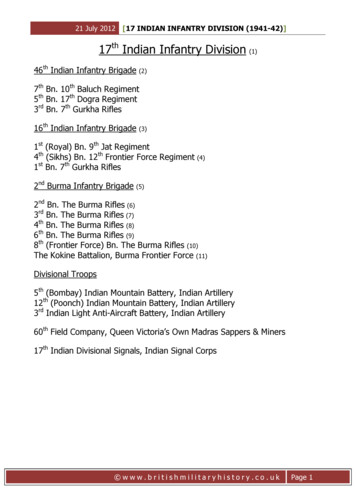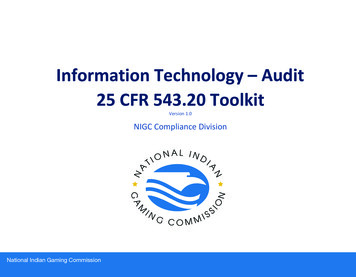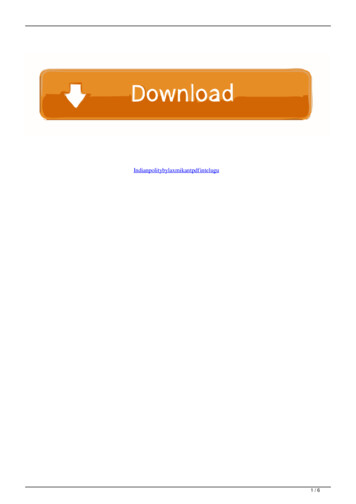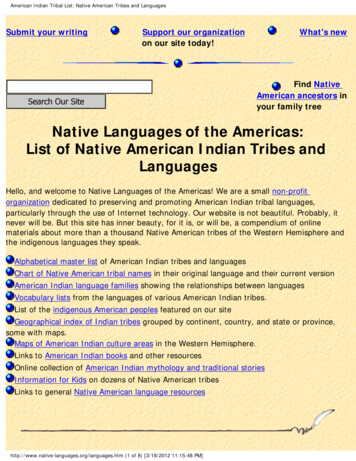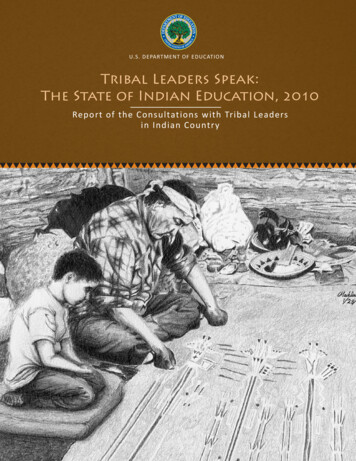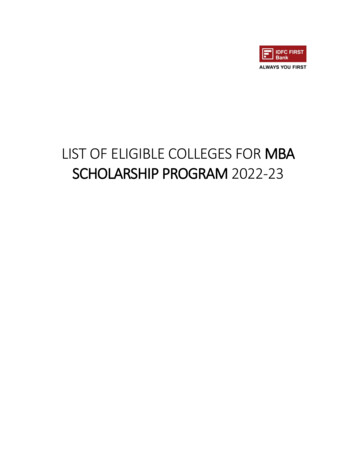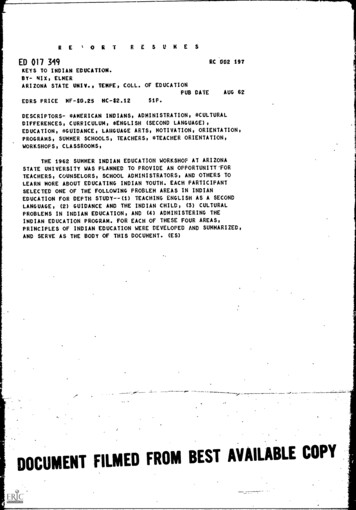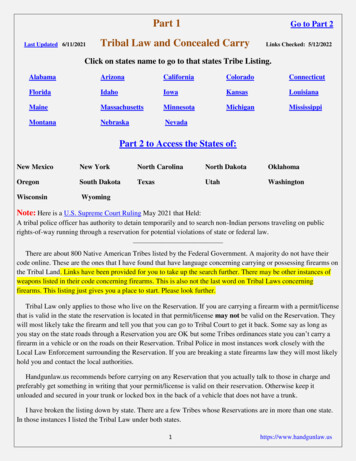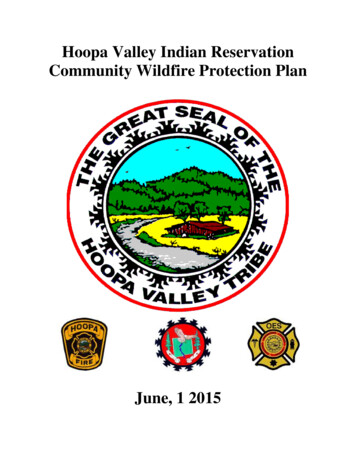
Transcription
Indian BoyhoodThe True Story of a Sioux Upbringingby Charles Ohiyesa EastmanEdited and Adapted by Michael Oren FitzgeraldIllustrated by Heidi M. RaschForeword by Charles TrimbleImagine a childhood full of adventure. Whereriding horses, playing in the woods, and huntingfor food was part of everyday life; where agrizzly bear, a raccoon, or a squirrel was yourfavorite pet. But imagine, too, being an orphanat the age of six, being forced off your land bysoldiers, and often going hungry. Such was theSantee Dakota childhood of famed AmericanIndian author, Charles Alexander Eastman, alsoknown as Ohiyesa.About Charles Eastman* The first great American Indian author,publishing eleven books from 1902-1918* Co-Founder of the Boy Scouts of America* A Field Secretary of the YMCAPublication Details* ISBN: 978-1-937786-56-4* Pub Date: June 2016* Price: 17.95* Trim Size: 8x10* Page Count: 44 pages, hardcover* Ages: 4 and up* An activist and lobbyist for the Sioux TribalNation* Graduated from Dartmouth College andattended medical school at Boston College andcared for Indians after Wounded Knee* The main character in the 2007 HBO film BuryMy Heart At Wounded Knee* Presented a special medal at the 1933 ChicagoWorld’s Fair honoring the most distinguishedachievements by an American Indian
Praise for Indian BoyhoodAdapted from Charles Eastman’s (Ohiyesa’s) 1902 autobiography Indian Boyhood, this story for young readers recounts his childhood and experiences as a Native American Small paragraphs of text are surrounded by Rasch’s illustrations,which feature brightly painted landscapes, members of Ohiyesa’s family, and borders that incorporate traditional motifs The preface and endnotes provide additional information about the illustrations and a more extensive account of CharlesEastman’s life.—Booklist“Michael Fitzgerald has captured the extraordinary values in a Sioux upbringingthrough interpreting Charles Eastman’s writing of his childhood as the freest in theworld. Educators and parents who wish to teach critical lessons on life and survivalto their young will find this book valuable as a readiness model for living.”—Vivian Arviso Deloria, former Executive Director of Education for the NavajoNation and Chairperson of the Navajo Nation Women’s commission“[This book] is very effectively edited by Michael Fitzgerald for today’s youngchildren of all races and ethnic backgrounds. . . . This version highlights theimportant points in Ohiyesa’s life in the wilderness, as well as the challenginghardships and the lessons he was taught in preparation for life as a warrior andhunter. All of the telling is complemented by Heidi Rasch’s exciting, colorful, andauthentic illustrations of the Dakota people and of nature that was so integral toIndian life. . . . Charles Eastman has long been a hero and role model to me. We areboth mixed-blood Sioux; he a Santee Dakota and me an Oglala Lakota.”—Charles Trimble, former Executive Director of the National Congress ofAmerican Indians, and author of IyeskaPraise for the Editor“My son, Michael Fitzgerald, has been a member of my family and the Crow tribefor over twenty years. Michael has helped to preserve the spiritual traditions of theCrow Sun Dance and he has helped to show us the wisdom of the old-timers.”—Thomas Yellowtail, Crow medicine man and Sun Dance chiefVisit the “press room” at www.wisdomtalespress.com for more information.
“Charles Eastman is the first major Indian author to write Indian history from theIndian perspective.”—Raymond Wilson, author of Ohiyesa: Charles Eastman, Santee Sioux, and editorof Native Americans in the Twentieth CenturySample PagesSelections from the Book
About Charles EastmanCharles Eastman (Ohiyesa) was born in a buffalo hide tipi in 1858 in western Minnesota. Hisfather, Tawakanhdeota (Many Lightnings), was Santee Dakota. His mother, Wakantankawin,(Great Spirit Woman), was the daughter of Wak inajin win (Stands Sacred), a MdewakantonDakota, and a well-known army officer, Captain Seth Eastman. She was also the granddaughterof Wichasta (Cloud Man), a Mdewakanton Dakota chief.Charles Eastman was raised in a traditional way of life of the Santee Dakota that existedbefore Europeans came to this continent. His contributions to our understanding of theAmerican Indian culture are so significant that at the 1933 Chicago World’s Fair Eastmanwas presented a special medal honoring the most distinguished achievements by an AmericanIndian.Eastman thought his father had been killed by the U.S. Government in the so-called “SiouxUprising of 1862.” In fact, his father had been pardoned by President Lincoln and in 1873returned to bring his fifteen-year-old son to live in the civilized world of his day.Eastman went on to receive his undergraduate degree from Dartmouth and his medicaldegree at Boston College. His first position was on the Pine Ridge Reservation in South Dakotaas the government physician for the Lakota Sioux tribe. Dr. Eastman was at Pine Ridge before,during, and after the “Ghost Dance” rebellion of 1890-91, and he cared for the woundedIndians after the massacre at Wounded Knee. In 1893 he accepted a position as field secretaryfor the YMCA, and for three years traveled extensively throughout the United States andCanada visiting many Indian reservations in an attempt to start new YMCA’s in those areas.In 1897 and ’98 Dr. Eastman lived in Washington D.C. as the legal representative andlobbyist for the Sioux tribe. During these years he met leaders from tribes around the country.In 1910 Eastman began his long association with the Boy Scouts, helping Ernest ThompsonSeton establish the organization based in large part on the prototype of the American Indian.It was also at about this time that he started to become in high demand as a lecturer and publicspeaker, traveling extensively in the US and abroad.Charles Eastman was the first great American Indian author, publishing the first of hiseleven books in 1902. Throughout his adult life, he worked tirelessly to improve the conditionson Indian reservations in the hope that they could become strongholds of tribal traditions—ineffect cultural homelands. He believed all “First Americans” could live between two worlds,so to speak, by successfully assimilating the best aspects of our modern civilization whilerejecting those features that are inconsistent with Christian and traditional native teachings.In 1928 Ohiyesa purchased land on the north shore of Lake Huron, in Ontario, Canada.For the remainder of his life, in addition to lecturing occasionally, he lived in his remote andprimitive cabin in communion with the virgin nature that he loved so dearly. He died in 1939,at the age of eighty.
About the EditorMichael O. Fitzgerald is the author and editor of more than fifteenbooks that have received over two dozen awards, including theprestigious ForeWord Book of the Year Award, the Ben FranklinAward, and the USA Best Books Award. At least ten of his books andtwo documentary films produced by him are used in high school anduniversity classes. Michael has taught the Religious Traditions of theNorth American Indians at Indiana University. He is an adopted son ofthe late Thomas Yellowtail, one of the most honored American Indianspiritual leaders of the last century. Working with the Lakota LanguageConsortium, he helped found the Crow Language Consortium, dedicatedto the preservation of the Crow language. Michael and his wife, awardwinning editor Judith Fitzgerald, live in southern Indiana and spend theirtime surrounded by their extended family.About the IllustratorHeidi M. Rasch was born near Stuttgart, Germany, to an EnglishIndian mother and a German father and has been painting sincechildhood. She and her family traveled to the Crow Reservation, whereher interest in America’s native peoples was intensified. Heidi went onto study fashion design and work in theater across Europe, includingParis’ famed Comédie-Française, before moving to America. For thepast decade, she has made annual trips to the American West to visitthe Crow and Shoshone tribal reservations, where she maintains manyclose relationships. She and her two daughters were adopted into theCrow tribe by Joe Medicine Crow, at the time the oldest male memberof the Crow tribe, and winner of the Presidential Medal of Freedom.She lives in Bloomington, Indiana.About the Author of the ForewordCharles “Chuck” Trimble was born and reared on the Pine RidgeReservation in South Dakota. He is an enrolled member of the Oglala SiouxTribe and was principal founder of the American Indian Press Associationand later served as Executive Director of the National Congress of AmericanIndians. In 1975 he represented U.S. Indian tribes at the charter meetingof the World Council of Indigenous Peoples in Copenhagen, Denmark. Healso served as a U.S. delegate at the U.N. Sub-commission on Prevention ofDiscrimination and Protection of Minorities in Geneva, Switzerland. Charleswas inducted into the South Dakota Hall of Fame in 2013. The author ofIyeska, he is now retired and lives in Omaha, Nebraska, with his wife.Visit the “press room” at www.wisdomtalespress.com for more information.
cared for Indians after Wounded Knee * The main character in the 2007 HBO film Bury My Heart At Wounded Knee * Presented a special medal at the 1933 Chicago World's Fair honoring the most distinguished achievements by an American Indian Publication Details * ISBN: 978-1-937786-56-4 * Pub Date: June 2016 * Price: 17.95 * Trim Size: 8x10
